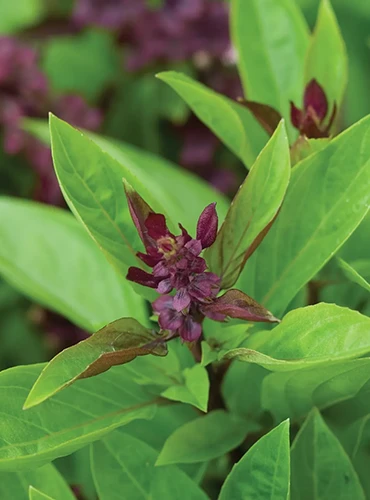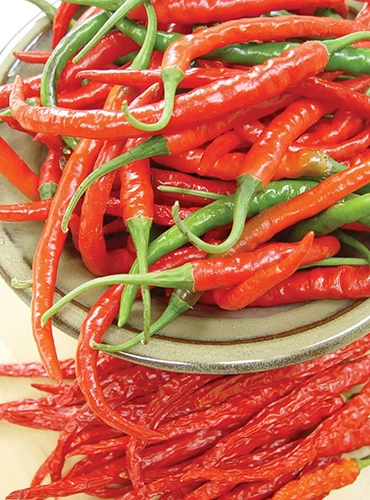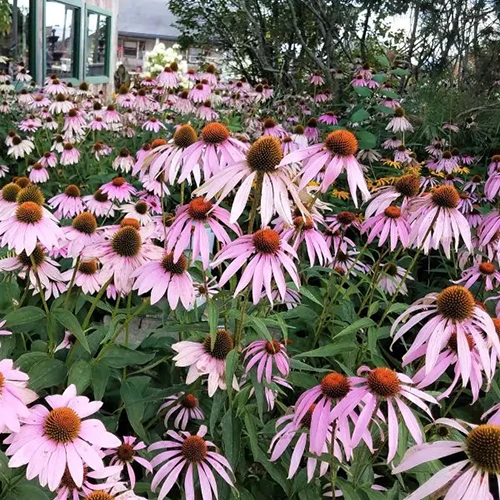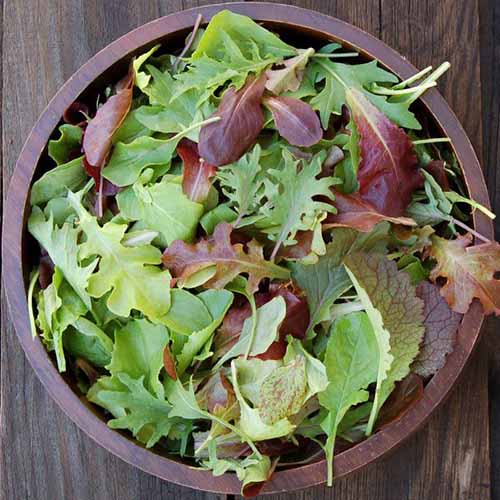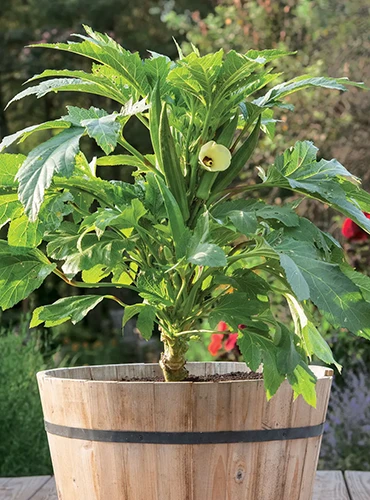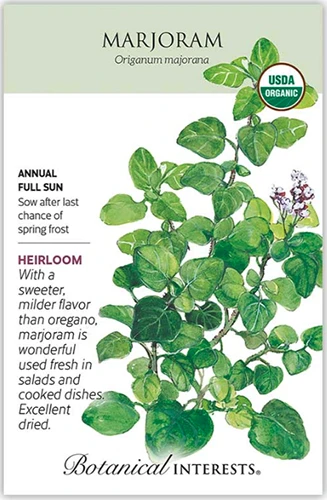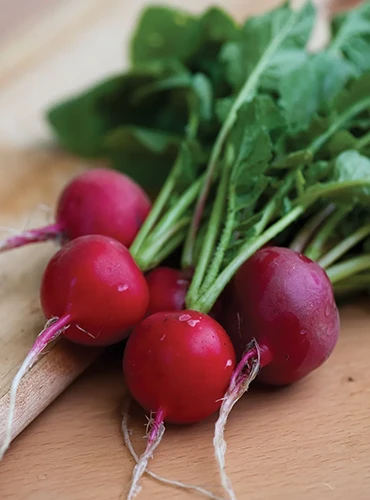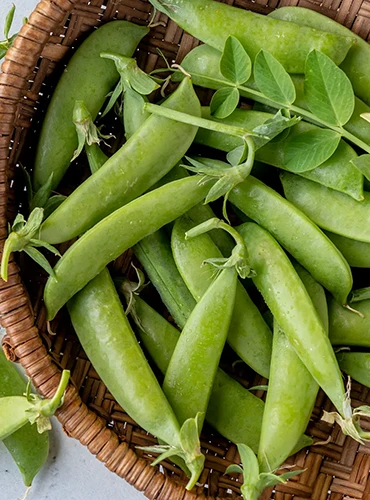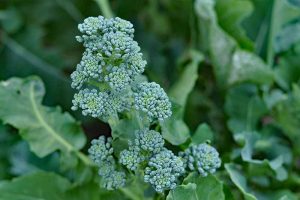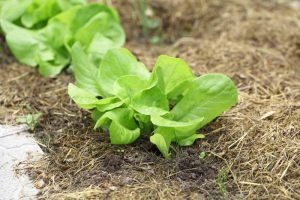As a matchmaker for my human loved ones, I’ll admit I don’t do so well. But when it’s time to pair okra plants with beneficial companions in my home garden, I have an enviable success rate.
Part of the reason is that okra, unlike some of the folks I’ve tried to fix up over the years, is easy to get along with.
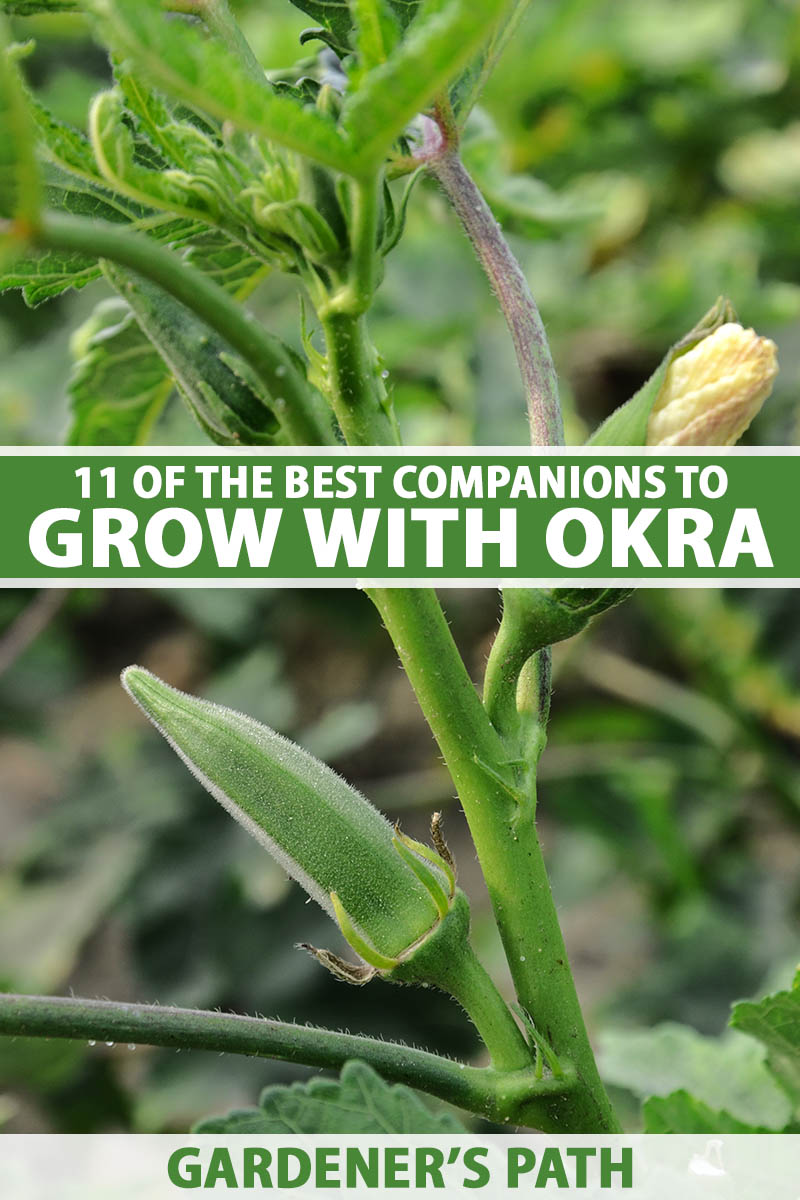
We link to vendors to help you find relevant products. If you buy from one of our links, we may earn a commission.
Known by the botanical name Abelmoschus esculentus, okra grows quickly and produces mightily in warm weather.
But even with its easy-going nature, okra can benefit when you take extra time to plan where it grows – right down to selecting the most helpful companion plants to grow nearby.
If you’re not familiar with companion planting, it’s the practice of pairing certain types of plants in the garden, landscape, or even in containers in a way that benefits one or both.
Certain companion pairings help gardeners grow vegetables or flowers with less effort or resources, while others promote higher yields or deter pests.
Other plants make a good match just because they look good together, grow at the same time of year, or have complementary sunlight or water needs.
We have an insightful guide on the scientific findings that guide companion planting, and that’s a good place to get the background on this helpful concept.
I’m also the first to admit that some oft-repeated companion planting ideas are merely wit and wisdom or even folklore. The best way to handle this practice is with your own careful trial and error.
Okra is not nearly as fussy about its companions as many high-producing vegetable crops (I’m looking at you, beans and garlic).
Still, it will grow even better if it’s close to certain highly compatible plants, from native coneflowers to aromatic herbs like basil to many legume varieties, including peas and beans.
With this guide, I can’t guarantee perfection for each pairing, but I can steer you towards 11 vegetables and flowers that are highly likely to benefit okra, or vice versa.
11 of the Best Companion Plants for Okra
Before we leap into specific suggestions, let’s look at some of the factors that determine which plants are good matches for okra and which ones usually aren’t.
Okra has a handful of traits that inform all these companion planting decisions.
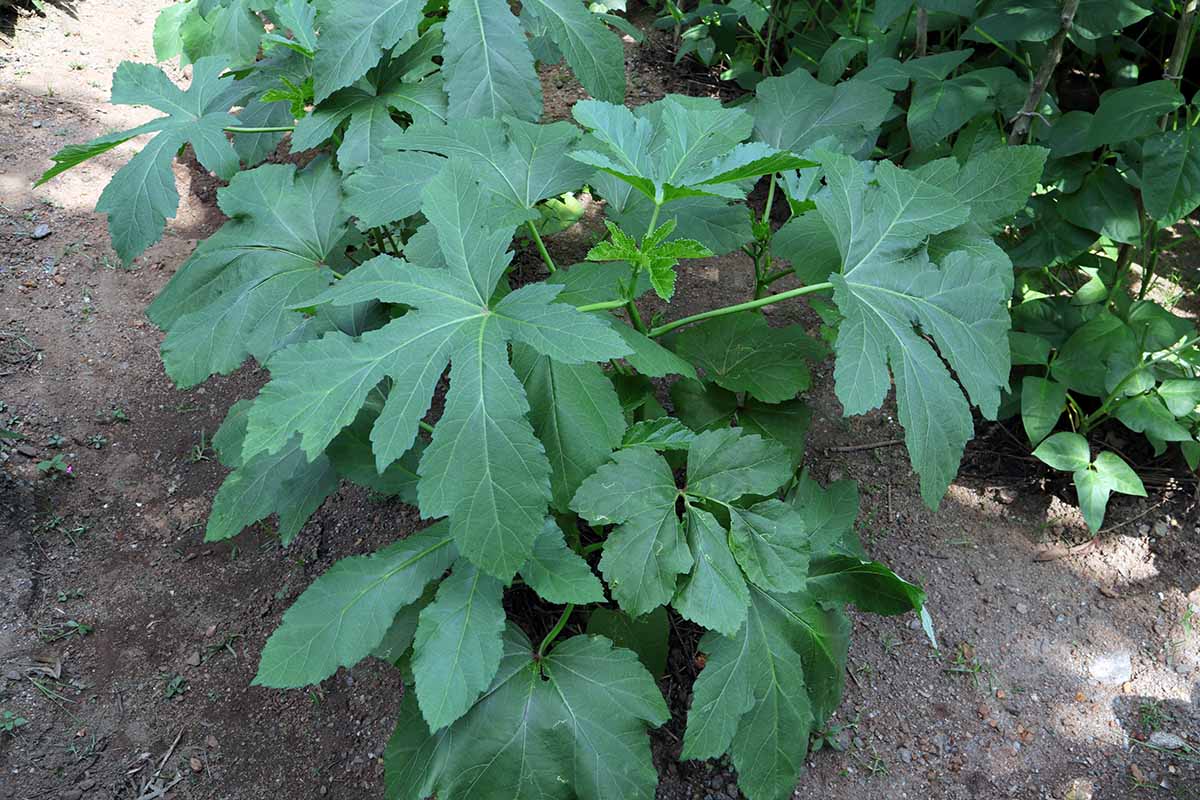
For one thing, it’s an annual, so you don’t necessarily want to grow it too close to perennials.
It develops a long taproot and a couple of feet of lateral roots, so it can easily take perennials with it when you try to uproot it at the end of the season.
It grows best in full sun, which means plants that could compete for rays aren’t the best neighbors.
Of course, its sun-loving nature and quick growth rate also allow A. esculentus to shade smaller plants from harsh summer sun, which might guide you to plant lettuce, spinach, or mesclun mix beneath its umbrella.
Okra relies on pollinators to fertilize its blooms, so aromatic, open-pollinated flowers are desirable companions – or its own blooms might help draw pollinators to other garden veggie plants like zucchini.
It also demands well-draining soil, so there’s no point planting it with flowers that prefer moist or wet soil, like cardinal flowers and swamp sunflowers.
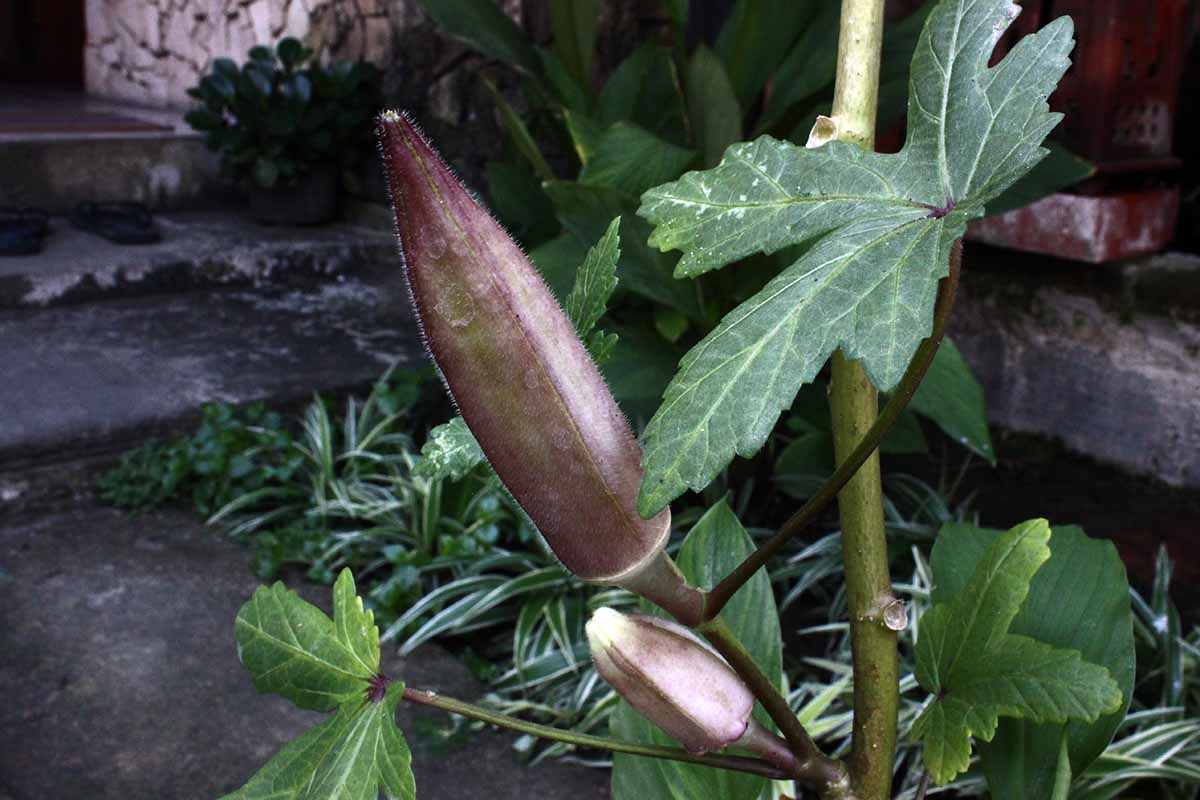
In general, this mallow family member will get by with average moisture and soil.
If you have space in a veggie patch that’s been amended with barrels of well-composted manure and has drip irrigation, well, okra would grow there.
But it’s more labor- and cost-conscious to save those areas for the plants that need substantial water and are heavy feeders – like acorn squash or corn.
Mature plants can grow four to six feet tall and spread two or more feet. When choosing their companions, you’ll want to consider space needs for both the okra and the other variety of flowers or vegetables.
Plants growing too close together can suffer from limited air circulation and excess humidity, which encourages certain pests and diseases.
Okra grows best from seed, but they’ll fail to germinate unless soil temperatures are at least 60°F.
That characteristic limits some companions and makes others ideal. You don’t want to disturb early spring-bearing veggies like, say, broccoli in order to sow okra in the same row or container in late spring.
But you could use that relatively late start to plant crops like radishes near the site where you intend to grow okra, and then harvest them before the new additions get so large they’d be casting shade.
While we vegetable gardeners tend to focus most on top yields for edible crops, it’s important to consider visuals when growing okra as an ornamental or alongside ornamental plants.
A member of the mallow family, which also includes hibiscus and hollyhocks, okra has beautiful blooms, but usually not until late in the summer.
The red stems or splotchy red and green leaves of certain varieties like ‘Red Burgundy’ can also draw you to plant this tropical as an edible landscaping plant.

But that only works if it’s growing and blooming at the same time as its companions, and if its coloring and leaf shape look good with the other plants that are nearby neighbors.
Phew, that’s a lot of “what if’s.” But once you see this list of desirable companions, you’ll quickly pick up on which ones offer the benefits you might be seeking. Let’s take a look.
Here are 11 of the best neighbors for okra plants.
1. Basil
Fragrant herbs can help deter certain insect pests, like whiteflies. And basil (Ocimum basilicum) is a fragrant herb that will help deter pests that could bother nearby okra.
Many agriculture experts agree that basil repels certain insect pests.
Still, even if that doesn’t work in your garden, basil has the auxiliary benefit of tasting great in stews made with okra, and attracting pollinators to your vegetable garden if it’s allowed to bloom.
The ‘Siam Queen’ variety typically used in Thai cooking is an extra aromatic choice with a strong licorice-anise scent and flavor.
If you opt for an edible flower window box, consider combining a red or short-pod okra plant with its hibiscus-like blooms and this Thai basil with magenta flowers.
‘Siam Queen’ is available in 200-seed packets from Burpee.
Another advantage of planting basil near okra is that both are annuals and grow only in warmer temperatures.
That means you can direct sow them at the same time or start them indoors on the same schedule.
And at season’s end, you can pull both from the garden plot at about the same time, a chore that’s trickier with many perennial herbs.
Learn to grow and care for Thai or sweet basil in our guides.
2. Beans
Like okra, beans, including Phaseolus vulgaris and P. lunatus species, thrive in direct sun and can grow in average soil as long as it drains well. There are two scenarios for growing the two together.
First, you can let the okra reach a foot tall and then plant pole beans so they can use the plant as a living trellis.
Or, you can grow bush beans at the foot of the okra plants to act as a living mulch for the soil.
In either scenario, the legumes will fix nitrogen in the soil, which is beneficial for the crops and whatever vegetables you plant in that same spot the following year.
I like the idea of planting lima or butter beans with okra companions because they’re both traditional Southern ingredients.
Because the limas take a while to reach maturity, about 60 to 70 days, they’ll be ready to harvest in late summer and early fall like the okra.
‘Henderson’ baby lima plants grow 18 inches tall and produce buttery beans, with four or five per pod, in 60 to 70 days.
Find ‘Henderson’ seeds available in various package sizes and in bulk from Eden Brothers.
If you’re interested in growing food to stock the freezer, both okra and any variety of green bean or butter bean are prolific and freeze well.
Learn more about growing green beans or lima and butter beans in our guides.
3. Cantaloupe
There are a couple of reasons why cantaloupe (Cucumis melo var. reticulatus) makes a good companion for okra and vice versa.
Both are sun-loving plants that mature in around 50 to 70 days, so they can share space in a plot that receives ample sun. You can water them on the same schedule, though the okra won’t need quite as much.
While the okra grows upright, the cantaloupe can trail along the ground, which will help the soil retain moisture and prohibit weeds.
To grow these companions in a small-space garden, raised bed, or large container, consider planting ‘Minnesota Midget’ cantaloupe with vines that spread only three feet.
Find ‘Minnesota Midget’ seeds in various package sizes from Eden Brothers.
You’ll want to plan so the melon can receive morning sun and so you have room to get to both plants to water and harvest.
You don’t have to plant the okra in the same fertile soil you use for the cantaloupe, though – it doesn’t need as much nutrition.
To keep the melon vines from taking over before the okra gets started, consider starting the seeds indoors before planting them out.
Our guide to growing okra explains this propagation method in detail.
If you’re already considering marigolds and oregano as companions, which we’ll describe in more detail below, they’re also suitable neighbors for cantaloupe, so that’s a win-win situation.
Find out how to grow and care for C. melo in our guide to cultivating cantaloupe.
4. Cayenne Peppers
A couple of pepper plants within the vegetable patch may deter cabbage worms, which feast on okra in addition to their many brassica victims.
I like to plant cayenne peppers (Capsicum annuum) so I can harvest both of the ingredients needed for hot pickled okra at the same time.
Cayenne is ready to pick about 80 days from transplant, so give it a head start on other garden veggies by sowing seeds indoors eight weeks ahead of your average last frost and then transplanting them out.
Cayenne pepper is available in 20-seed packets from Burpee.
Peppers also love warmer temperatures and need moderate watering, so you can tend to them at the same time as okra when rain doesn’t supply sufficient moisture in summer’s heat.
Learn to grow and care for cayenne peppers in our guide.
5. Coneflowers
Tall native plants and wildflowers will attract airborne pollinators to all vegetable plants, not just okra!
Coneflowers (Echinacea spp.) are one of the best for that purpose.
The classic ‘Magnus’ variety of E. purpurea with its pink-purple flowers also looks appealing next to the yellow blooms of an okra plant.
Live ‘Magnus’ coneflowers are available in #1 containers from Nature Hills Nursery.
When you grow an herbaceous perennial like the coneflower near an annual vegetable, leave enough space between the two so you can uproot the annual at the season’s end.
If you neglect to clear plant debris in the fall, certain insect pests can overwinter and reappear next spring to demolish that year’s crop.
If it’s too complicated to separate the two once they’ve stopped blooming and producing, grow one or both varieties in containers so you can move and toss the plants at will.
Learn more about growing and caring for coneflowers in our guide.
6. Cucumbers
Like their vining cantaloupe relatives, cucumbers (Cucumis sativus) make good companions because they also like full sun.
The cucumber plants can either suppress weeds as trailing vines or use the taller plant as a de facto trellis.
I like to grow ‘Homemade Pickles’ because it only reaches four or five feet long even though it’s a vining variety, so your okra plant will offer sufficient support.
Find ‘Homemade Pickles’ cucumbers in 42-seed packets from Botanical Interests.
Cucumbers are even more valuable as a companion than melons because they produce bushels of high-quality fruits if you keep them picked.
Time the harvest for both using your gardening calendar, and you can keep the two varieties picked for peak production throughout the summer and into early fall.
And the two veggies make delicious canned pickles if you end up with a bumper crop of one or both.
Learn how to grow and care for cucumbers in this guide.
7. Marigolds
Shorter annual flowers are a good match because the blooms are attractive, the plants grow and flower in the summer, and they attract pollinators.
They’re also ready to pull out of the garden at about the same time.
Marigolds (Tagetes spp.) are a good example. They repel certain garden pests, including the root-knot nematodes that sometimes harm crops.
The fast-growing annual flowers also act as a “living mulch” that inhibits weeds and retains moisture when planted nearby.
‘Vanilla’ African marigolds grow to 18 inches and have creamy blooms that complement red okra pods or the yellow blooms in an ornamental bed or an edible container garden.
‘Vanilla’ seeds are available from True Leaf Market.
Other varieties grow anywhere from six to 24 inches tall, with none that get so high they’ll shade okra from the sun.
But you do need to be careful to plant marigolds where other crops won’t shade them too much, either.
Learn to grow marigolds in our guide.
8. Mesclun
Sometimes A. esculentus is more benefactor than beneficiary of our companion selections.
Just so with mesclun. This blend of baby leaf greens and herbs is sown and harvested in a spring mix, and it’s one of the first vegetables to appear in the spring garden.
If you plant it while temperatures are above freezing but below 50°F, the mesclun is ready to start harvesting in 30 days.
Here’s where okra comes in. By the time temperatures are in the 60s and it’s warm enough to transplant or sow, it’s starting to get too hot for mesclun.
But if you sow the okra indoors four to six weeks ahead of planting it out, you can place the seedlings where they’ll grow to shade the mesclun in increasingly hot weather, thereby extending the spring mix harvest for a couple of weeks or maybe more.
Find mesclun mix in 750-seed packets from High Mowing Organic Seeds.
Learn to grow mesclun spring mix in our guide.
If you’re a fan of growing vegetables in containers, you can sow a more compact variety of okra with mesclun sown in the same pot around the base of the larger plant.
That way, you can expand the growing season for one or both by moving the container indoors if it’s too cold for the okra or too warm for the mesclun.
Find ‘Baby Bubba,’ a compact cultivar, in 60-seed packets available from Burpee.
9. Oregano
Like many aromatic herbs, oregano will deter pests and attract flying pollinators.
It’s also handy as a companion if you plant a mounding or spreading variety, like sweet marjoram (Origanum majorana).
It will trail over the ground below as a living mulch, suppressing weeds and helping to retain moisture in the soil.
Find sweet marjoram in 480-seed packets from Botanical Interests.
Oregano is a perennial, and you might find it difficult to pull okra at the season’s end without destroying the herb at the same time.
You can work around that issue by potting up the oregano to winterize ahead of clearing the larger vegetable plants, planting so much oregano you don’t miss a few if they’re accidentally eliminated, or planting the oregano in containers you set near your raised bed – though that robs you of the ground cover benefit.
Learn to grow and care for oregano here.
10. Radishes
Planting radishes (Raphanus sativus) is a time-honored way to achieve an early harvest and save space in the veggie patch.
Planted ahead of or beneath okra, radishes will break up the soil to ease the way for the bigger plants’ roots.
They’ll still be ready to harvest a couple of weeks before the okra grows large enough to compete for space or water.
One of my favorite radishes for this purpose is ‘Cherry Belle,’ a round red variety that’s ready to harvest 22 days, give or take, from sowing.
Conventional and organic ‘Cherry Belle’ seeds are available in various package sizes from Burpee.
At the rate radishes mature, you may have enough time to successively plant three or four harvests before the weather gets too warm for them or the okra steals their sun.
Learn more about growing radishes in our guide.
11. Snap Peas
The edible pod peas known as snap peas, Pisum sativum var. macrocarpum, will also grow best in full sun and can thrive in average soil.
As companions, you’ll want to grow them for a fall harvest. That way, they can fix nitrogen in the soil alongside the okra, which only grows when the soil has warmed to a consistent 60°F.
This type of pea, though, needs chilly temperatures to flourish. If you sow vining snap pea seeds about eight weeks before your first fall frost, they can scale the mature okra plants for support.
I enjoy the taste and the texture of the ‘Super Sugar Snap’ variety, which matures in 64 days and grows 60 to 72 inches tall.
Sow four or five seeds two inches apart in a circle at the base of an okra plant that is at least two feet tall already. No thinning is required.
Find ‘Super Sugar Snap’ in 300- or 900-seed packets, available at Burpee.
If you run into an early frost before the peas have formed pods, harvest the shoots to eat in salads.
Bad Companions
Okra is such an agreeable vegetable to grow in the home garden that when I talk about “bad” companions for it, I should really say “less ideal.”
It doesn’t have any known foes, though veteran gardeners will tell you not to plant it before or after sweet potatoes or squash, since all three are highly susceptible to root-knot nematodes.
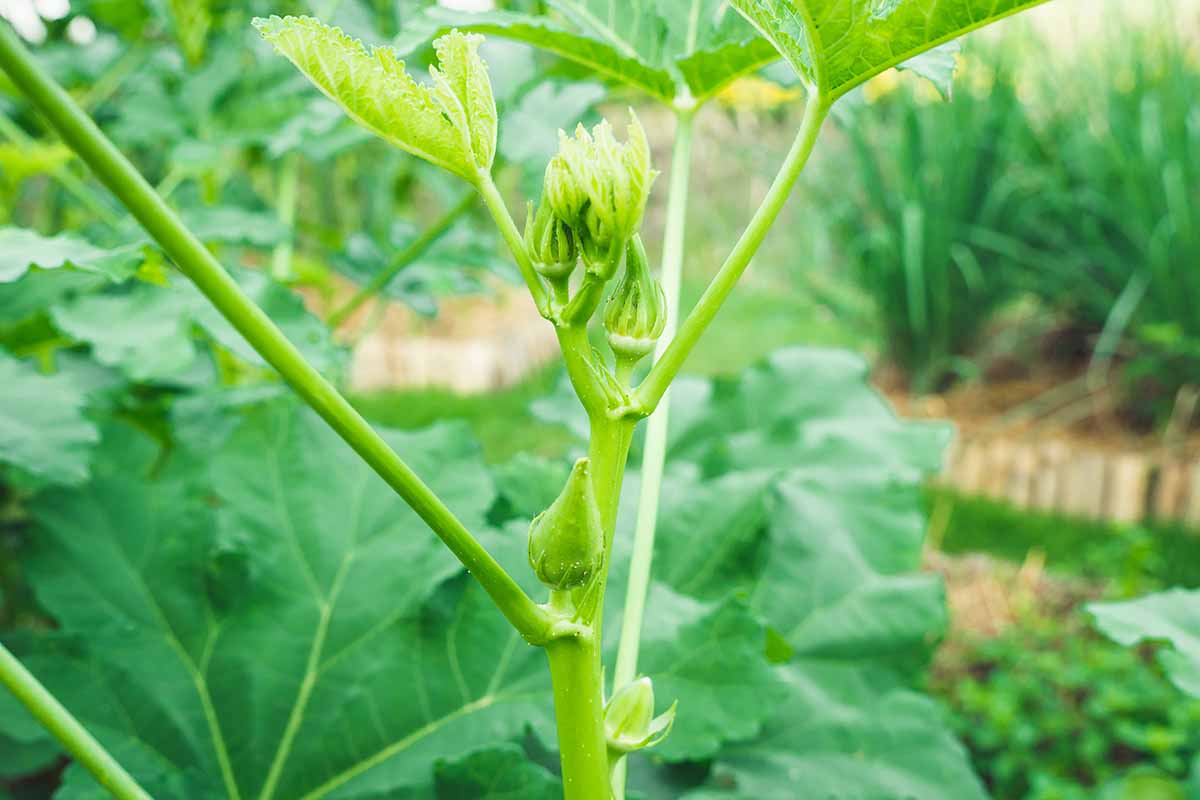
Also avoid planting anything that doesn’t share similar growing requirements nearby – any plants that need more nutrient-rich soil, for example, or more or less water, or are far more frost tolerant.
It simplifies vegetable growing when you can tend all nearby plants at the same time, whether you’re watering, fertilizing, or providing row cover.
But on the other hand, remember that many companions can be planted alongside in containers or separate raised beds while still offering benefits.
Okra also needs full sun to yield at its max. So don’t plant it beneath a tree or perennial ornamental vine, or too close to any annual vegetables or flowers that will quickly grow taller and cast shade.
Certain indeterminate tomatoes, corn, ‘Mammoth Russian’ sunflowers, and vigorous vines like birdhouse gourds all come to mind as possible competitors for the sun.
Because okra is planted so late in the spring, even veggies that won’t grow taller than it at maturity can present a problem if you plant them first and they grow quickly.
Broadleaf mustard greens, lacinato kale, and potatoes all fall into this category. They shoot up so quickly they can overwhelm a newly germinated seedling, or deprive it of food and water.
I’d like to remind you one more time about those massive roots on a mature okra plant, too.
There has been many a growing season that ended with my husband literally standing and jumping on a hefty garden spade in his efforts to dig up a tenacious taproot so we could winterize the veggie bed.
This is why it’s a bad idea to plant perennial herbs or flowers within range of those roots unless you make contingency plans (like with oregano, described above).
They’ll suffer root disturbance during the cleanup, and while okra is delicious and prolific, it’s not worth sacrificing precious perennials.
It’s convenient to take advantage of its affinity with other plants when planning your garden, but be careful not to plant brassicas, cucurbits, legumes, or nightshades in a bed with okra if you plan to grow a bigger crop of those same types of veggies the following year.
Carefully rotating crops prevents all sorts of soilborne ailments from getting established, and also helps build the soil and prevent insect pests.
You can find more tips on garden planning and additional advice for first-time vegetable gardeners in our guide.
A-Okay to Grow Together
Okra in the home garden already has decent productivity and an ornamental appearance going for it. But its wide-ranging compatibility with other vegetables and flowers is a substantial value-add.
I often opt for this plant when I’m having difficulty allocating space in my raised beds.
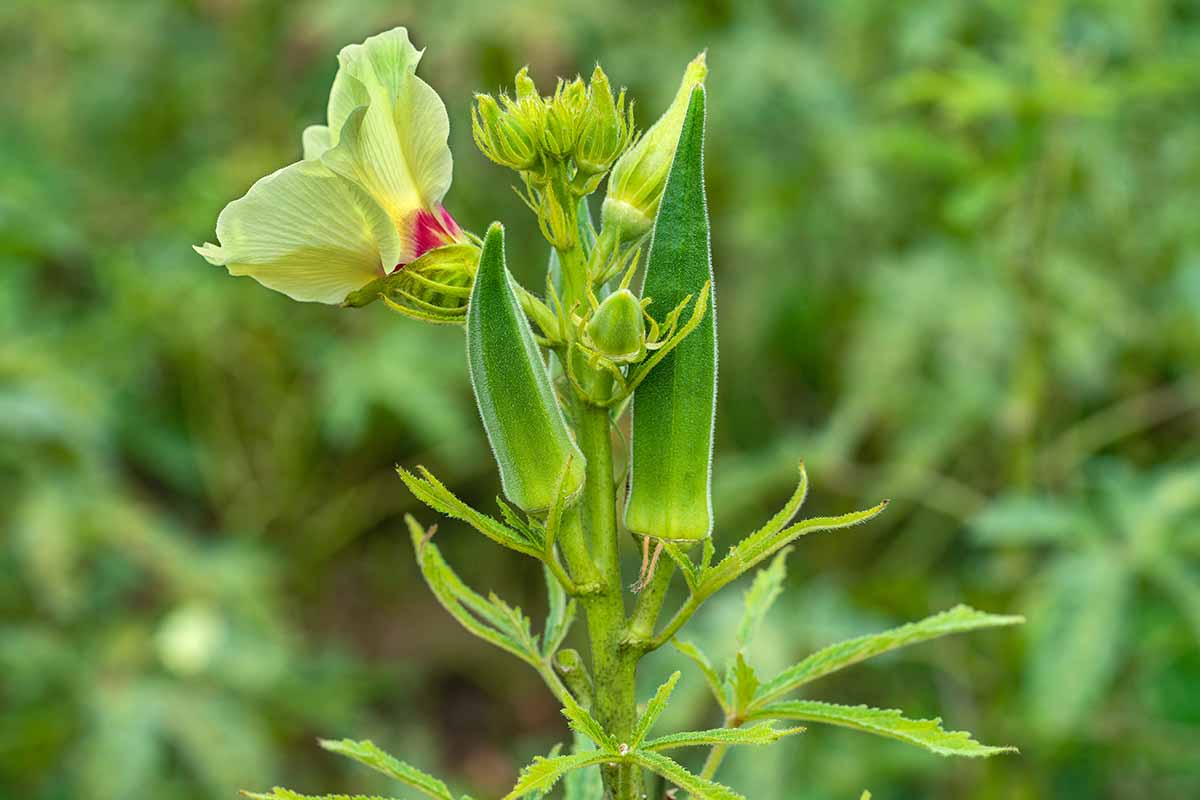
Unlike most other vegetables, it grows merrily next to nightshades, cucurbits, legumes, alliums, and herbs, so it’s a good fallback when there’s room next to any one of those plants and the other candidates have a conflict.
If you have any companion planting wisdom to share, please add it to the comments section below. You can also pose questions if you feel a topic wasn’t addressed above.
And if this coverage has you considering planting okra for the first or the 50th time, check out these okra guides for additional information:
